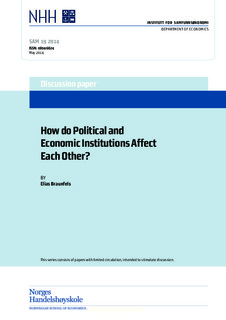| dc.contributor.author | Braunfels, Elias | |
| dc.date.accessioned | 2014-06-03T11:29:32Z | |
| dc.date.available | 2014-06-03T11:29:32Z | |
| dc.date.issued | 2014-05 | |
| dc.identifier.issn | 0804-6824 | |
| dc.identifier.uri | http://hdl.handle.net/11250/195776 | |
| dc.description.abstract | This paper provides evidence for the mutually reinforcing relation of political and
economic institutions. To overcome problems of endogeneity I utilize lag instruments within a GMM
framework for dynamic panel data. Employing recently developed tests, I show that limiting the
number of lag instruments and collapsing the instru- ment matrix eliminates many and weak
instrument biases. My major findings are that (i) improving economic institutions has a large
positive effect on future po- litical institutions, and (ii) political institutions have a
positive but quantitatively smaller effect on current economic institutions. In addition, (iii)
political instability positively affects future political institutions. In line with predictions
from the in- stitutional literature, the timing of effects is such that political institutions
depend on lags of explanatory variables, while economic institutions are contemporaneously
determined. Moreover, results are driven by countries with initially low political institutions
implying that in these countries, much is to be gained from institutional
reform. | nb_NO |
| dc.language.iso | eng | nb_NO |
| dc.publisher | Norwegian School of Economics. Department of Economics | nb_NO |
| dc.relation.ispartofseries | Discussion paper;19/2014 | |
| dc.subject | VDP::Samfunnsvitenskap: 200::Økonomi: 210::Samfunnsøkonomi: 212 | nb_NO |
| dc.title | How do political and economic institutions affect each other? | nb_NO |
| dc.type | Working paper | nb_NO |
| dc.subject.jel | P16 | |
| dc.subject.jel | O10 | |
